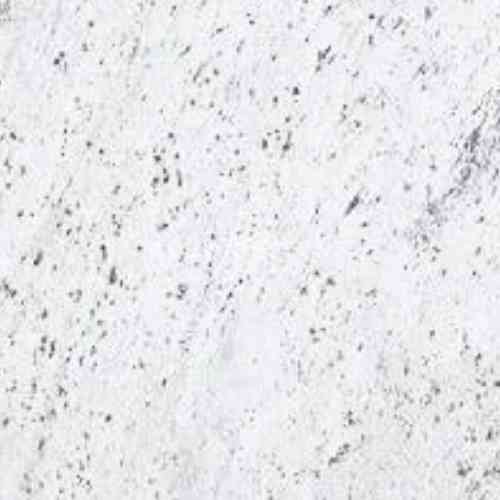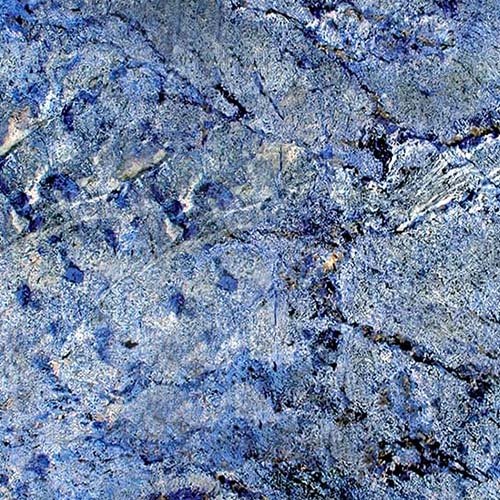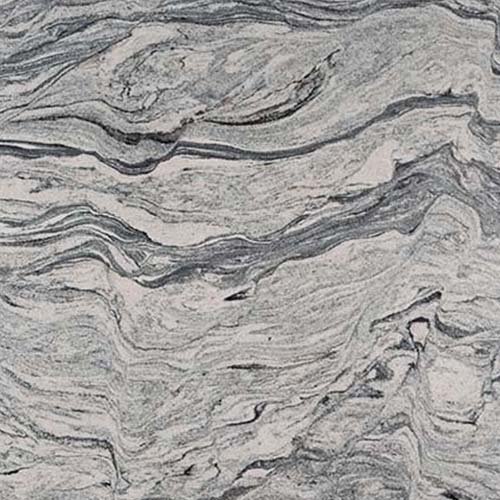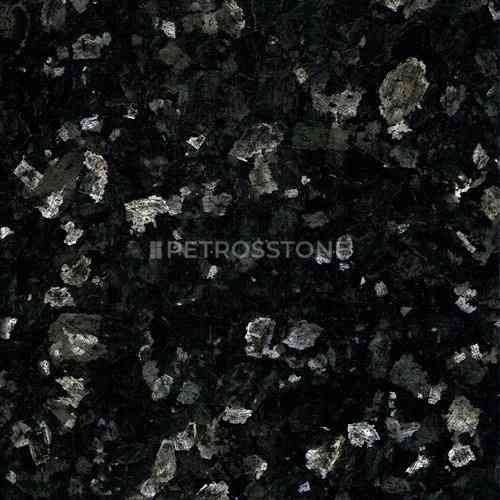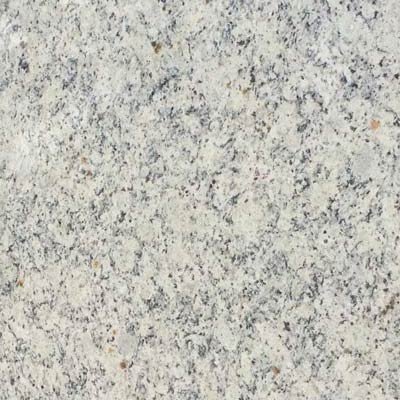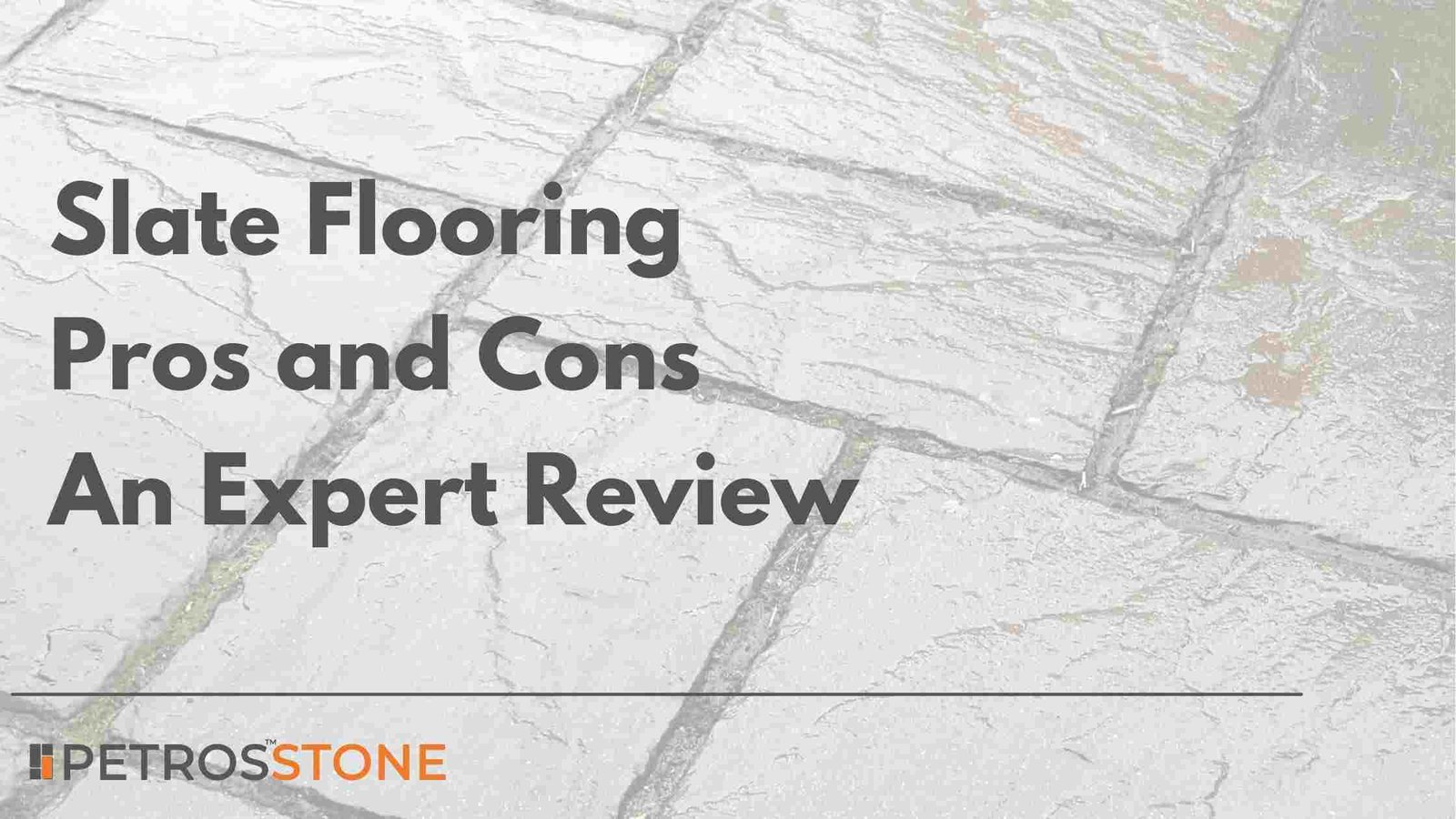
When it comes to flooring materials and designs, a few materials are known to offer durability along with their natural elegance. And slate is one such material. For centuries, slate flooring has been preferred in private, public, and outdoor spaces– owing to the durability and aesthetics. The textured surface of slate floor tiles makes it dent and scratch-proof, promising performance.
While this rustic material adapts to most design settings, there are several challenges associated with it.
Pros and Cons of Slate Flooring
| Pros | Cons |
| Durable material, enhances the longevity of the flooring | Expensive as compared to the alternatives |
| Sealed slate floors are easy to clean | Porous in nature, it demands sealing |
| Natural elegance owing to the varying textures and a broad palette of colors | Color palette limited to earthy tones as compared to ceramic tiles |
| Versatile in terms of applications– suited for interiors and exteriors | May feel uneven or rough barefoot |
| Exhibit anti-slip properties | Can prove to be brittle upon contact with heavy or sharp objects |
| Retains heat– ideal flooring choice with underfloor heating technology | Stays cold without heating |
In this article, we will dive deep into the material’s properties, pros, cons, and learn what the experts advise.
- The Origin and Composition of Slate
- Popular Surface Finishes for Slate Flooring
- Where to Use Slate Flooring?
- Pros and Cons of Slate Flooring
- Common Challenges with Slate Flooring
- Modern Solutions to Slate Flooring Challenges
- Natural Slate vs Slate Ceramic Tiles
- Slate Flooring – Timeless and Tactile Richness
- Summary
- Key Takeaways
The Origin and Composition of Slate
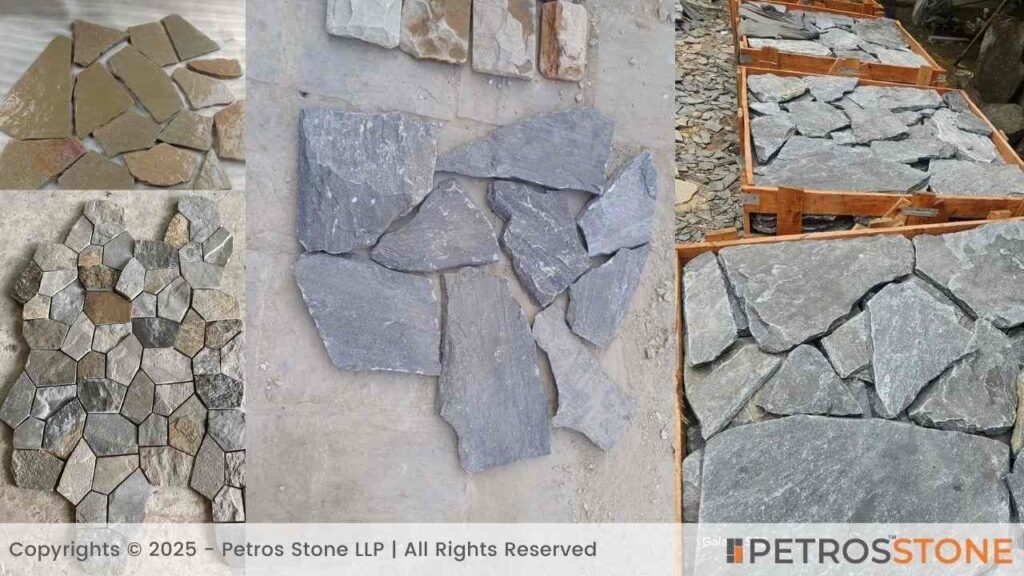
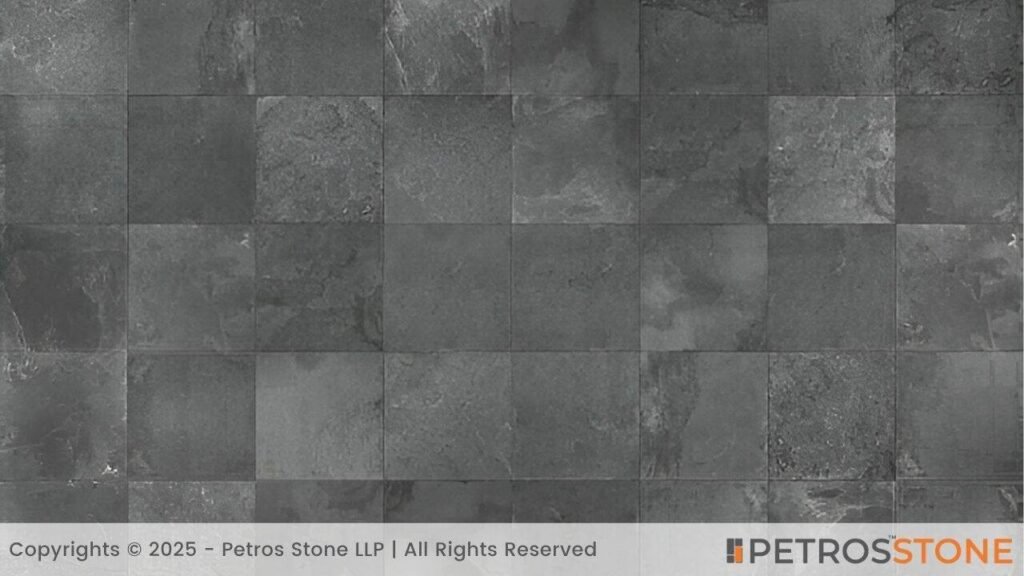
Slate is categorized as a metamorphic rock. It is derived from a composition of clay minerals and fine quartz known as shale. Over millions of years, shale is subjected to intense heat and pressure, transforming into slate with its characteristic layered structure.
Globally, slate deposits are found in the USA, China, Brazil, and Spain, among other regions. In India, more than 20 varieties of slate stone exist. These are broadly classified based on their origins, i.e., North Indian Slate and South Indian Slate, depending on their geographical origin.
North Indian Slate and South Indian Slate, depending on their geographical origin. North Indian slates like Peacock, Himachal Green, and Deoli Green are known for their vibrant greens, bold blacks, and unique textures, often sourced from Rajasthan and Himachal Pradesh. South Indian slates such as Autumn Rustic, Rustic Black, and Crazy Pattern feature earthy, rustic tones and irregular shapes, typically quarried in Andhra Pradesh and Tamil Nadu.
Slate is a highly durable material with minute grains and a foliated composition. Its split-face texture, mineral composition, natural gradient, and variations impart unique aesthetics to each piece. These flattened sheets have been used as roofing and flooring materials for ages. Being a fine-grained metamorphic rock, it’s naturally durable and exhibits anti-skid properties even with a wet surface.
Popular Surface Finishes for Slate Flooring
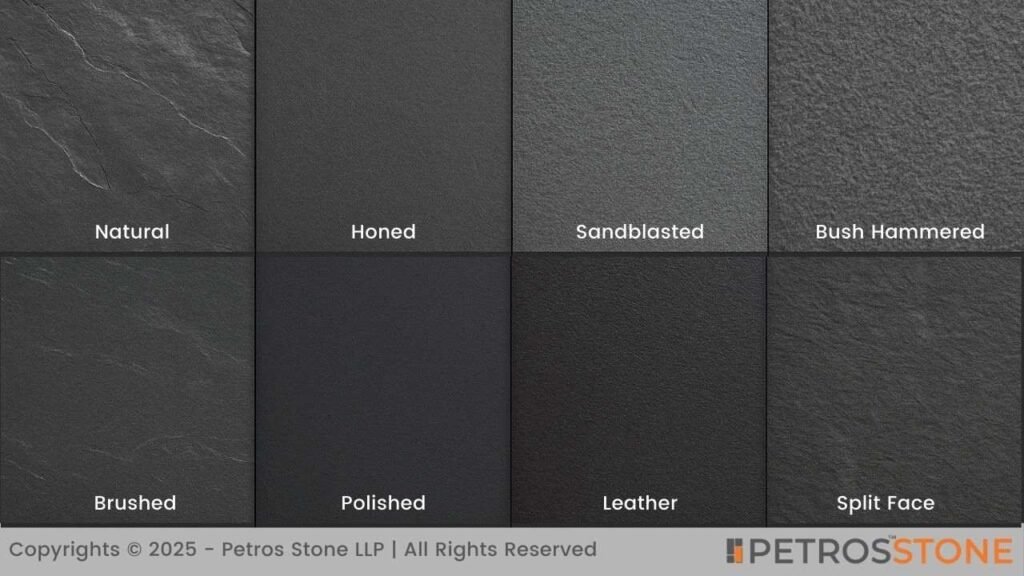
Slate is known as a versatile stone. Apart from the numerous color options, it also has a broad palette in terms of the surface finish.
Table for Popular Slate Finishes
| Surface Finish | Key Characteristics | Best Use Cases |
|---|---|---|
| Natural Finish | The natural finish in slate refers to its raw texture, exhibiting a clefted surface. This finish is achieved by splitting a stone slab with a hammer and chisel along the cleave line. Natural slate flooring is slip-resistant and exhibits rustic aesthetics. | Outdoor patios, rustic interiors, anti-slip areas |
| Honed Finish | Honed finish refers to the smooth finishing with a matte look. As compared to natural slate, the honed surface is easier to clean, but it can prove to be more slippery | Living rooms, kitchens, interior spaces |
| Sandblasted Finish | Sandblasted slate has a slightly rough texture. However, the overall appearance seems tidy, and sandblasted slate floor tiles are commonly used in high-traffic areas. | High-traffic zones, commercial flooring |
| Bush Hammered | A bush-hammered finish created a rugged and anti-slip surface. Slate flooring in this surface finish is ideal for outdoor applications. | Outdoor stairs, driveways, poolside areas |
| Brushed Finish | A brushed slate exhibits a flat yet scratched surface finish. It is achieved by using a rotary wire brush against a natural slate surface. The worn-in look is known to enhance the character of a space. | Vintage-style interiors, lounges, feature flooring |
| Polished Finish | Polished slate flooring imparts a reflective shine. It is more common in tabletops, countertops, and wall cladding. | Tabletops, vanity tops, wall cladding |
| Leather Finish | Suede-like tactile finish; subtle sheen and textureLeather finish results in a look and feel resembling suede. Suede-like tactile finish; subtle sheen and texture | Bathrooms, countertops, luxury interiors |
| Split Face Finish | The split face slate flaunts a rough texture with flat slate forming subtle ripples. This surface finish is commonly used in feature wall cladding. | Feature walls, façade panels, decorative cladding |
Where to Use Slate Flooring?
Slate is a highly durable and adaptable natural stone. Its sturdiness makes it a perfect fit for a wide range of applications. The layered texture, along with the rustic tones, imparts both functionality and aesthetics in the interiors or outdoors.
Patios
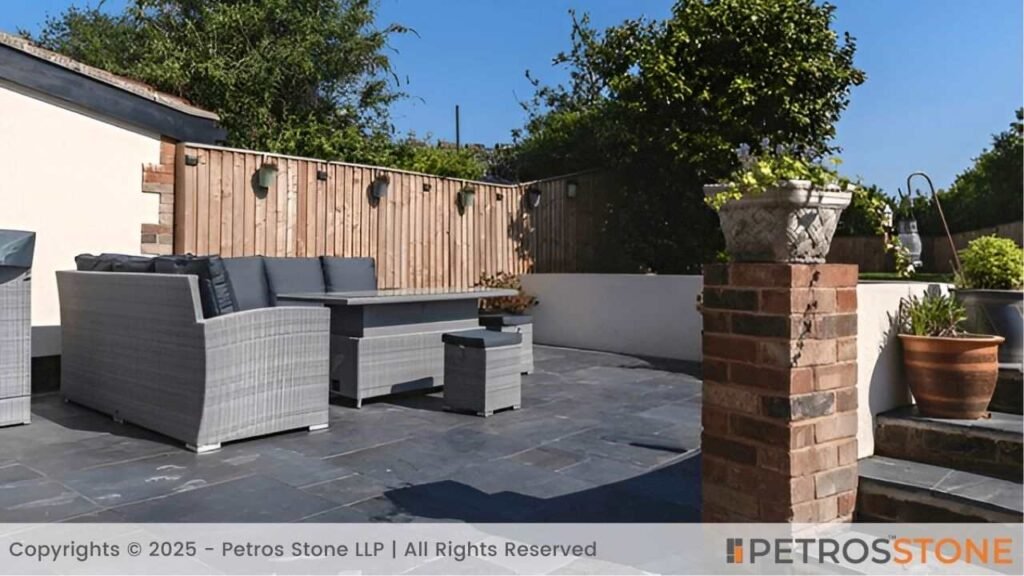
A high-quality slate floor is known to withstand extreme weather conditions, making it one of the most preferred choices for patios. The anti-slip properties ensure functionality in the rainfall-prone areas.
A crazy pattern slate flooring in patios blends beautifully with the natural greens, crafting a well-balanced hardscape and softscape.
Bathroom
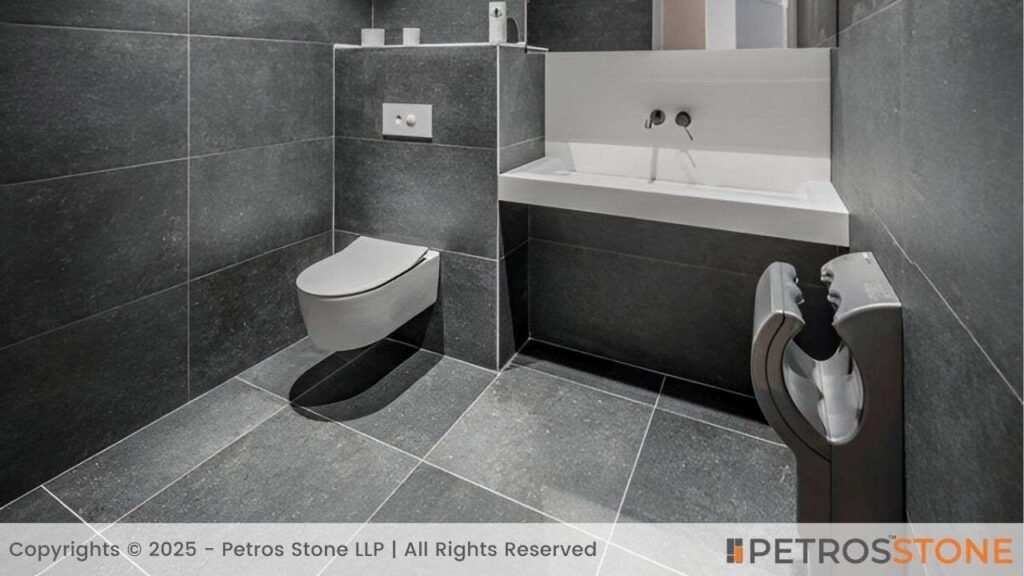
If you’re looking for a unique design apart from the typical ceramic tiles, slate flooring is a stylish pick for bathrooms. Natural slate floor tiles, when sealed properly, are a good choice owing to their anti-slip properties, promising safety in the wet areas.
Entryways
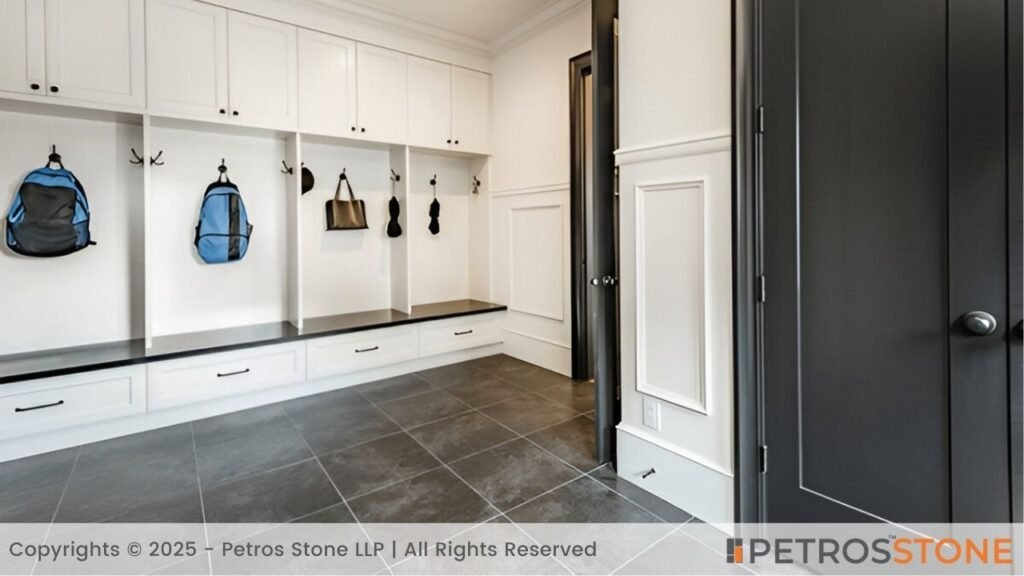
Installing slate flooring in entryways curates an earthy palette and sets a welcoming tone. Furthermore, the durability of the material makes it an ideal choice for high-traffic zones.
Pool Deck
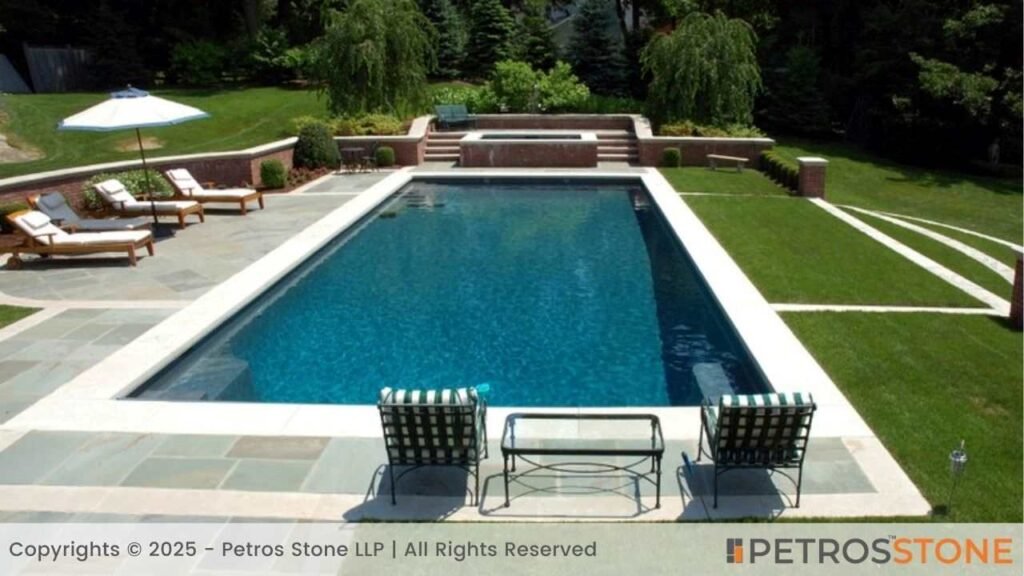
As slate flooring is available in plenty of earthy tones, it is a popular pick for pool decks for seamless blending with the landscape design. Apart from the aesthetics, its durability, low maintenance, and the versatility to generate patterns make it a preferred choice.
Lawn Stepping Stones

Slate flooring also serves as an accent feature in lawns in the form of stepping stones. Its layered texture offers a natural and rustic essence to tie the landscape design together.
Pros and Cons of Slate Flooring
| Pros | Cons |
| Durable material, enhances the longevity of the flooring | Expensive as compared to the alternatives |
| Sealed slate floors are easy to clean | Porous in nature, it demands sealing |
| Natural elegance owing to the varying textures and a broad palette of colors | Color palette limited to earthy tones as compared to ceramic tiles |
| Versatile in terms of applications– suited for interiors and exteriors | May feel uneven or rough barefoot |
| Exhibit anti-slip properties | Can prove to be brittle upon contact with heavy or sharp objects |
| Retains heat– ideal flooring choice with underfloor heating technology | Stays cold without heating |
Common Challenges with Slate Flooring
While slate flooring may have several advantages, there are a few challenges associated with the material, too.
Porosity and Flaking

While slate, being a non-porous natural stone, is a common myth, it’s important to understand that not every type of slate is non-porous. Low-grade slate is porous, which leads to water absorption over time. As moisture seeps inside the material, it leads to flaking of the slate flooring.
Expert’s Advice: With numerous slate varieties, picking the right one for your space can be a challenging task. You must consult a stone expert for high-quality and dense slate for flooring. Make sure to purchase the material from a reliable supplier. Ensure sealing of the surface during installation. In order to keep up with the appearance and non-porosity of the flooring, schedule resealing periodically to prevent moisture from seeping in.
Staining and Mildew
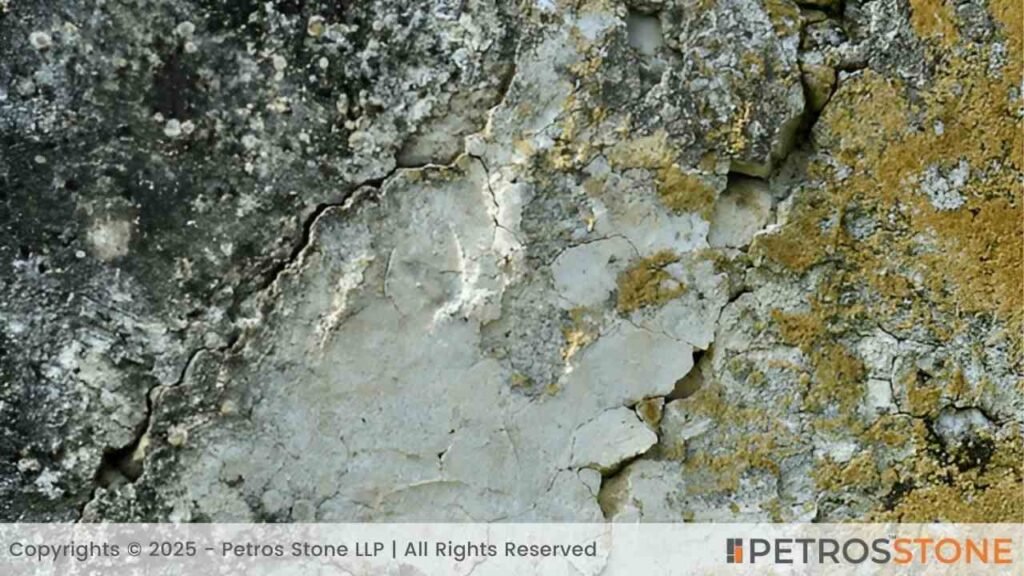
Non-porous slate can absorb water and spills if not cleaned instantly. It leads to staining, bacterial or mildew growth if left untreated for a long time.
Expert’s Advice: Don’t let the spills seep into the flooring and stain it. As soon as you witness a spill, clean it. Ensure regular cleaning and proper ventilation in the damp areas to avoid mildew growth. Sealing the slate flooring with a stone surface sealer helps minimize the absorption of moisture and prevents stains.
Cleaning Challenges
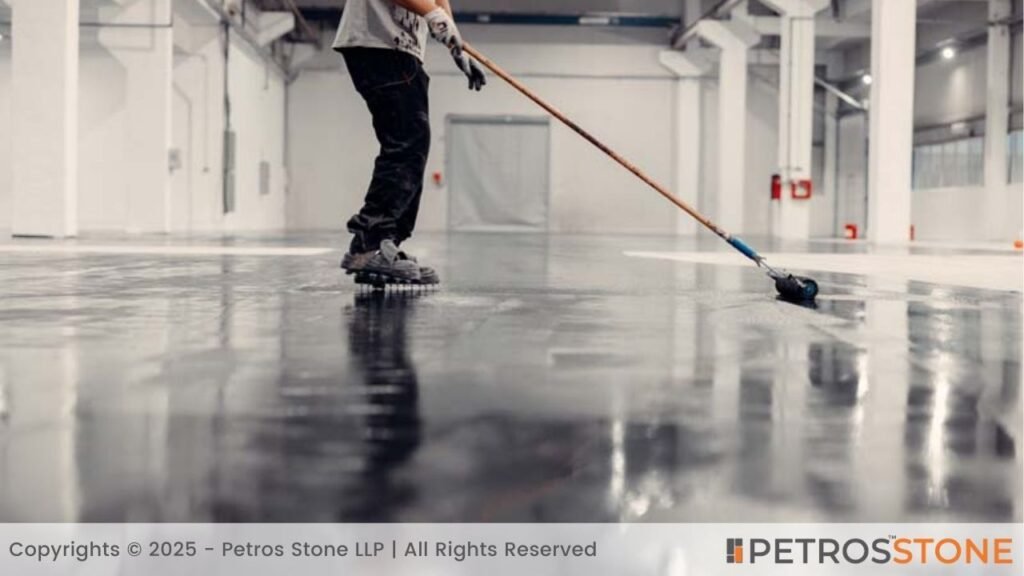
Slate flooring is chemically sensitive. You can’t use acidic cleaners to remove stains or dirt, as they may strip off the natural shine and lead to dullness of the natural surface. Strong cleaning solutions may ultimately lead to flaking of the material.
Expet’s Advice: Don’t use harsh chemical cleaners. Rather, opt for mild and pH-neutral floor cleaners. Regular dry mopping or vacuuming can help keep the floor clean. Make sure not to use a vacuum cleaner with a beater bar, as it may damage the flooring.
Rust Formation
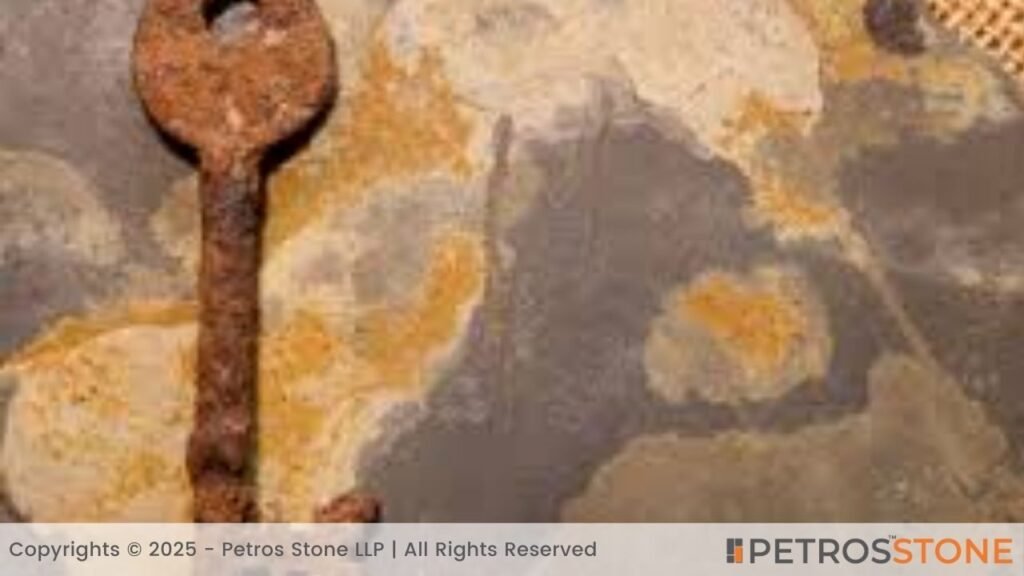
There are different types of slate flooring available in the market. And the composition for each varies. Several slate stones comprise iron oxide minerals, which, when exposed to water, may lead to rust formation. It ultimately stains the surface.
Expert’s Advice: Consult a stone expert and inspect the type of slate before installing the flooring. Avoid adding slate flooring rich in iron oxide minerals to the wet areas.
Physical Damage
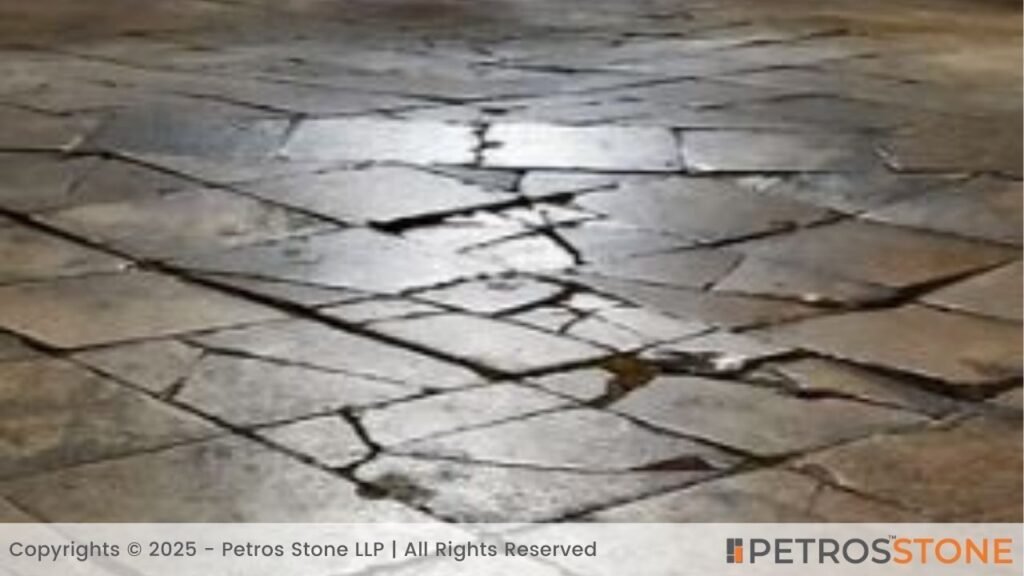
Some slates can be brittle. Sliding heavy furniture or contact with sharp objects may lead to cracking and chipping of the flooring.
Expert’s Advice: Avoid dragging heavy or sharp furniture across floors. Always use furniture pads or lift heavy items to avoid physical damage.
Cold Underfoot
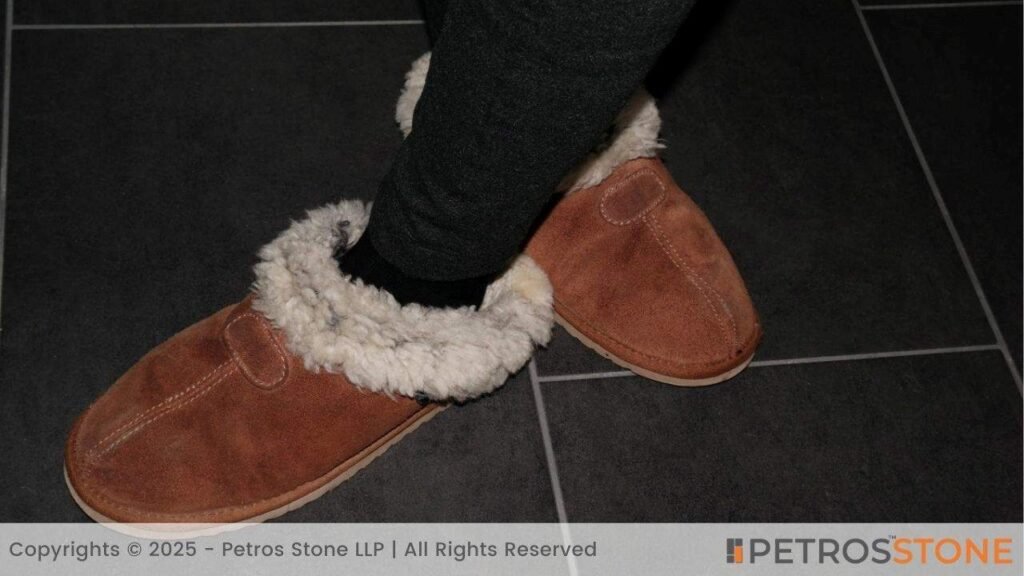
Slate is known for its heat retention when coupled with heating systems. In the absence of a radiant heating system, the flooring remains cold and is uncomfortable during winter.
Expert’s Advice: Install radiant heating to maintain comfort during winter. Alternatively, you can even strategically add rugs or carpets for warmth.
Modern Solutions to Slate Flooring Challenges
Slate flooring, along with introducing a rustic charm to a space, also complements modern designs. And with innovations, today, there are solutions to the typical flooring challenges that occur with slate tiles.
Glossy Sealer
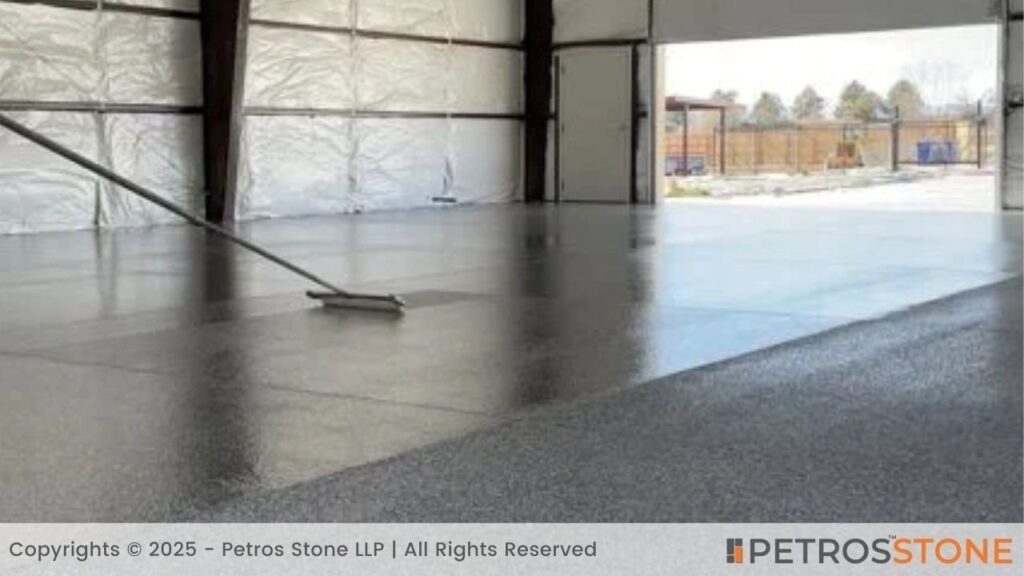
Not everybody likes the matte look of slate flooring. And at the same time, polished slate isn’t always functional as the material loses its anti-slip properties through this surface finish. This is where glossy sealers come into the picture.
Coating the surface with these sealers helps enhance the appearance of slate flooring. These impart a glossier and polished look to the flooring, amping up the aesthetics. While a glossy sealer enhances shine and protects the floor against moisture, the polished surface may also make scratches more visible.
Pro-tip: In order to maintain the sealer’s properties, ensure reapplication on a timely basis as suggested.
Clear Sealer
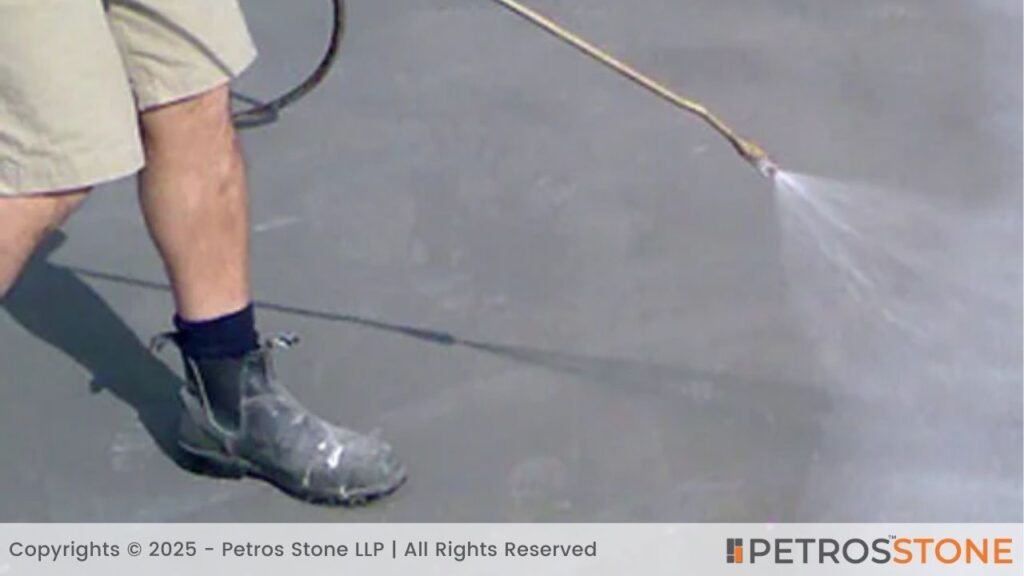
The surface finish of a flooring depends upon the design. While some designs demand glossy floors, other designs are complemented by slate in its natural form. However, as not every type of slate is non-porous, clear sealers help enhance the longevity.
These sealers help minimize the porosity of stone while retaining the natural color, texture, and aesthetics. Once you coat the flooring with a clear sealer, the color may seem darker; however, it returns to its original shade once the sealer has dried.
Slate Ceramic Tile
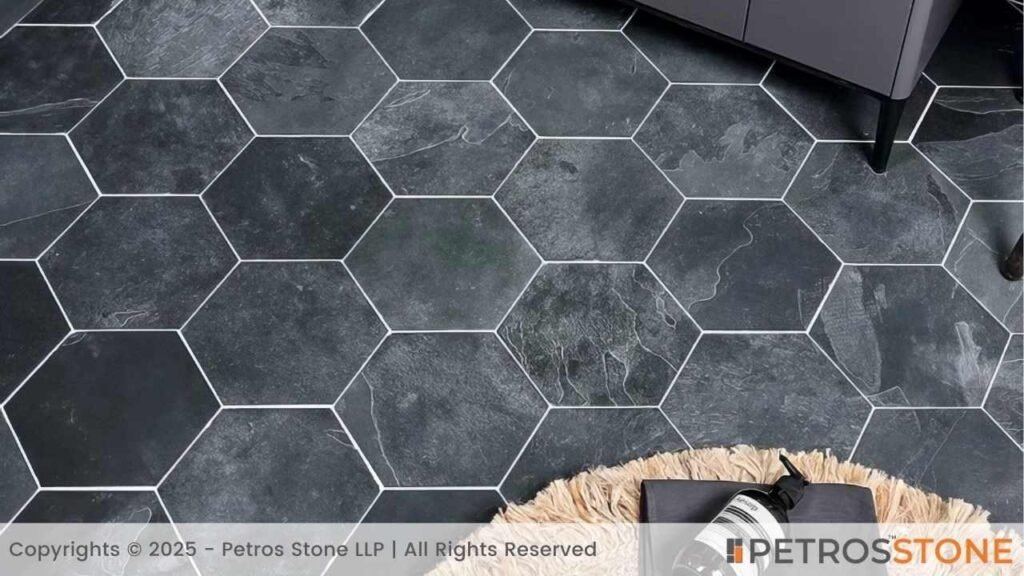
The modern design world has now been introduced to slate ceramic tiles, mimicking the texture and tones, while minimizing the porosity of the material. As ceramic tiles are available in a particular size, it eases installation.
Radiant Heating
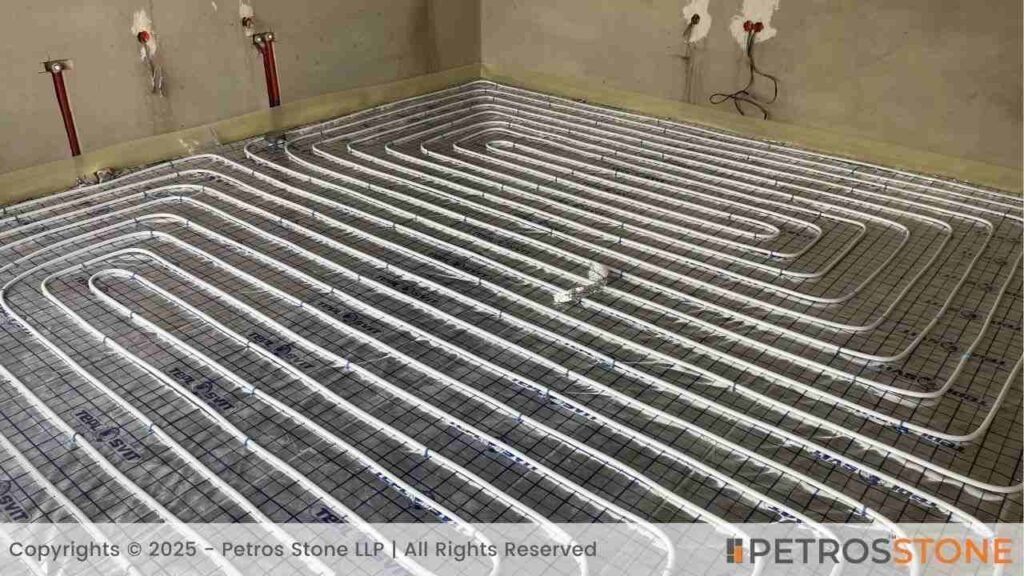
The common challenge of cold floors with natural slate floor tiles isn’t an issue anymore, owing to the underfloor heating systems. Installation of radiant heating systems neutralizes the issue and keeps the slate warm and comfortable underfoot.
Natural Slate vs Slate Ceramic Tiles
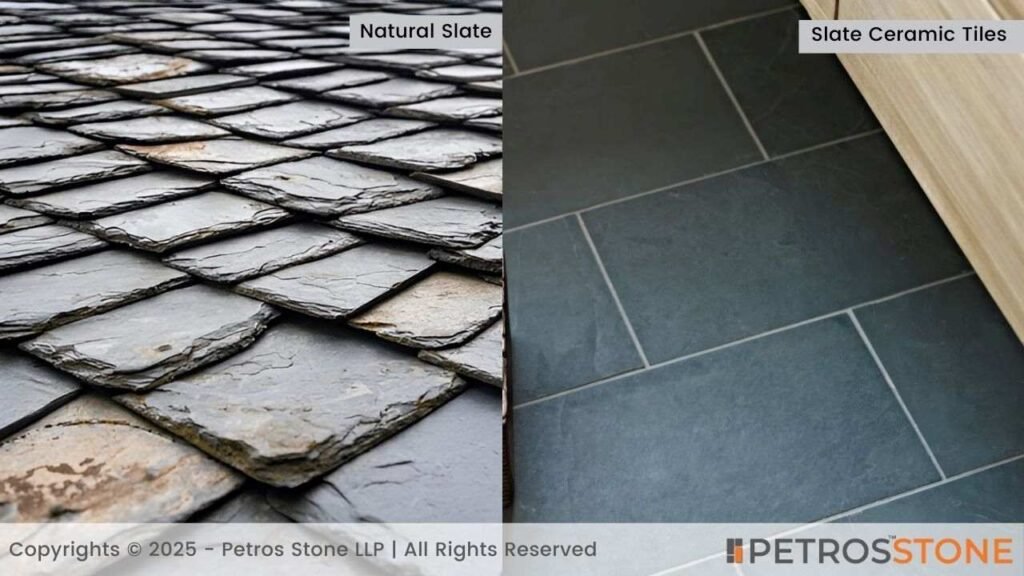
While slate flooring offers its unmatched authenticity, slate-looking ceramic tiles are growing in the market as an alternative, too. Let’s dive deep into a comparative analysis between the two:
Key Differences between Natural Slate Flooring and Slate Ceramic Tiles
| Criteria | Natural Slate Flooring | Slate Ceramic Tiles |
|---|---|---|
| Appearance | When it comes to natural slate, owing to the composition of metamorphic rock, every slab has its unique tone, texture, color banding, and gradient variations. With natural slate flooring, no two pieces will be identical– adding to the organic aesthetics and introducing timelessness to a space. | A slate ceramic tile mimics the appearance of slate through printing or embossing techniques. In that case, the texture, veining, and colors are often replicated, leading to an overall uniform look. Repetition makes the flooring lose the natural essence introduced by natural stone. Slate ceramic tiles, however, may work for spaces that demand a uniform look. |
| Tactility | Natural slate has a natural feel underfoot– slightly rough, textural, and earthy. Owing to its clefted surface, it’s naturally slip-resistant and ideal for outdoors, kitchens, or even bathrooms. | When it comes to ceramic tile, the depth in terms of touch is often missing. With a smooth finish, they feel more manufactured than natural. While natural slate flooring wins for a sensory experience, one may consider installing ceramic tiles for spaces demanding barefoot comfort. |
| Pricing | The pricing of natural slate installation varies based on the grade, finish, and source. However, the installation costs are often high owing to specialized labor for installation, levelling of the material, and sealing treatments. | Ceramic tiles also offer comparative prices. |
| Maintenance | Natural slate requires sealing upon installation and periodic resealing to prevent moisture absorption, staining, and flaking. It also needs gentle and specialized non-acidic cleaning agents to prevent dullness of the natural sheen. | On the other hand, ceramic tiles are low-maintenance and can be cleaned with standard household cleaners. |
Slate Flooring – Timeless and Tactile Richness
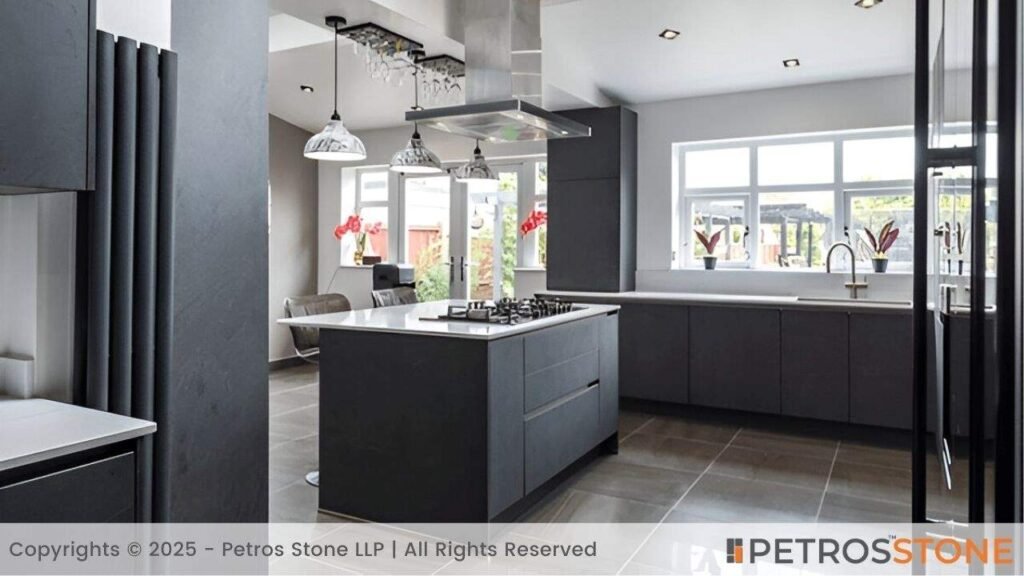
Slate is a beautiful and timeless flooring material, breathing life into a space and enhancing its durability. With modern advancements in terms of sealants, underfloor heating systems, slate flooring has now become one of the preferred choices for designers aiming at rustic designs.
Consult a stone expert, understand the types of slate flooring options, analyze what works best for your space, and introduce a natural material to your mood board to deliver a lifetime of value.
Speak to our stone experts today.
Summary
Slate flooring stands out as an aesthetic and durable material with its natural beauty, texture, and design versatility. Its earthy palette and textured surface make it an ideal choice for both interiors and exteriors.
However, a few varieties exhibit porosity, staining, and flaking challenges that can be addressed with regular upkeep and specialized sealers. Furthermore, the issue of cold underfoot can be treated with modern technology like radiant heating. Hence, introducing the authenticity of natural slate to flooring isn’t a challenge anymore.
Key Takeaways
- Natural slate is a metamorphic rock exhibiting unique properties. Each piece has a distinctive texture and tone.
- Being durable and versatile, owing to a variety of shades and finishes, slate flooring is suitable for bathrooms, entryways, patios, pool decks, lawns, etc.
- With finishes ranging from natural clefted to polished, brushed, honed, and several other surface finishes, the look and feel of a space can be manipulated with slate.
- Staining, flaking, porosity, and cold underfoot are a few of the manageable challenges with slate floors that can be addressed with modern solutions.
- While ceramic slate tiles are maintenance-free, they’re equally pricey and lack the authentic feel.
- Expert consultation is the key to picking the right and high-grade slate and finish for better performance.
Feel free to get in touch for a free consultation, quote, and get a detailed understanding from our experts here at Petros®. Visit https://petrosstone.com/ or call +91-8446360361 and WhatsApp

Hello!
I’m Tanika, an architect and writer, blending design expertise with a passion for storytelling. At Petros Stone, I help readers navigate through the complex material choices and empower them to craft well-informed and beautiful spaces through natural stones.
Brown Granite
White Galaxy Granite
Blue Bahia Granite
Silver Cloud Granite
Black Pearl Granite
Dallas White Granite


